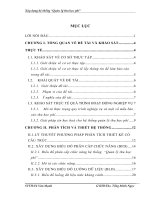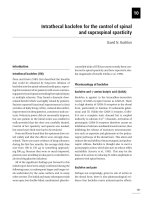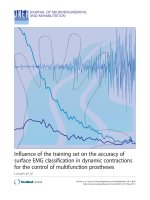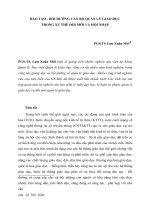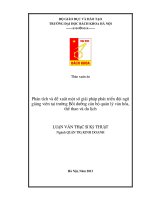Effect of soil solarisation for the control soil born pathogen S. rolfsii causing stem rot of chilli (Capsicum annuum L.) - TRƯỜNG CÁN BỘ QUẢN LÝ GIÁO DỤC THÀNH PHỐ HỒ CHÍ MINH
Bạn đang xem bản rút gọn của tài liệu. Xem và tải ngay bản đầy đủ của tài liệu tại đây (202.46 KB, 5 trang )
<span class='text_page_counter'>(1)</span><div class='page_container' data-page=1>
<i><b>Int.J.Curr.Microbiol.App.Sci </b></i><b>(2017)</b><i><b> 6</b></i><b>(10): 4913-4917 </b>
4913
<b>Original Research Article </b>
<b>Effect of Soil Solarisation for the Control Soil Born Pathogen </b>
<i><b>S. rolfsii</b></i>
<b>Causing Stem Rot of Chilli (</b>
<i><b>Capsicum annuum</b></i>
<b> L.) </b>
<b>Prem Naresh*, Ved Ratan, Virendra Kumar and Upesh Kumar </b>
Department of Plant Pathology, C. S. Azad University of Agriculture and Technology,
Kanpur-208002, India
<i>*Corresponding author </i>
<i><b> </b></i> <i><b> </b></i><b>A B S T R A C T </b>
<i><b> </b></i>
<b>Introduction </b>
The chilli (Capsicum annuum L.) also known
as Mircha is an important spice and vegetable
crop belonging to the family Solanaceae. In
India, chillis are grown in almost all the states
of the country.
In India, area, production and productivity of
chilli were 767.23 million ha. 1202.94 million
tones and 1.6 mt/ha, respectively
(Parthasarathy and Kandiannan, 2010).
There are so many diseases responsible for
lowering down the production and
productivity of chilli. Among fungal diseases,
stem rot of chilli caused by Sclerosium rolfsii
Sacc. is an important disease in India.
This is the first report of <i>S. rolfsii causing </i>
collar rot in chilli from Gujarat (Lukose et al.,
2003). The disease is also known as foot rot/
Southern blight/ white stem rot/ stem rot in
different places of the country. Chilli is highly
susceptible to the disease and causing 50 to
60 per cent seedling mortality (Lukose <i>et al., </i>
2003).
The severe stem rot of chilli causing 30-40%
seedling rot was observed in a 2.0 ha at
farmer’s field in Saurashtra (Gujrat) India
(Bhoraniya <i>et al., 2002). It is a destructive </i>
plant pathogen with an almost unlimited host
range. In chilli crop the yield product is the
fruit which directly consumed by people.
Afield experiment was conducted to study, the effect of soil solarisation for the control of
<i>S. rofsii pathogen causing stem rot of chilli. Solarisation is a covering the soil with </i>
transparent polythene sheet (400 gauges) for 6 week during hot summer months (May and
June) showed an increase in the soil temperature (up to 4-60C) and conservation of
moisture (5%) when compare to unsolarised plot(as control). In a field experiment
naturally infected soil with stem rot of chilli, with ten replication carried out during
2008-09, 2009-10 and found that a significant reduction disease incidence was recorded in
solarised plot as against non solarised plot (control).The average soil temperature (50C)
were increases (41.8-46.40C) which is lethal to soil pathogen and decreases disease
incidence. A pot experiment were also conducted in net house during 2009-10 sowing 25
seeds per 30cm.diameter earthen pots having four treatment and three replications and
found maximum disease incidence (100%) in control (uncovered with polythene and
non-irrigated as compared to covered with polythene and non-irrigated pots(20%).
<b>K e y w o r d s </b>
Chilli (<i>Capsicum </i>
<i>annuum</i> L.),
<i>Sclerosium rolfsii</i>
Sacc, Soil
solarisation and
Stem rot.
<i><b>Accepted: </b></i>
29 September 2017
<i><b>Available Online:</b></i>
10 October 2017
<b>Article Info </b>
<i>International Journal of Current Microbiology and Applied Sciences </i>
<i><b>ISSN: 2319-7706</b></i><b> Volume 6 Number 10 (2017) pp. 4913-4917 </b>
</div>
<span class='text_page_counter'>(2)</span><div class='page_container' data-page=2>
<i><b>Int.J.Curr.Microbiol.App.Sci </b></i><b>(2017)</b><i><b> 6</b></i><b>(10): 4913-4917 </b>
4914
Hence chemical controls are not
recommended as the presence of residues in
green fruit may leads health hazards.
Pathogen is soil born in nature and disease
inoculums increase in proportion from year to
year. Therefore soil solarisation was required
for the controlling soil borne pathogen. Soil
solarisation by mulching soil surface with
plastic film during summer months raises soil
temperature to a lethal level. This method has
been successfully employed in eliminating
several soil borne pathogens. Management of
disease through this, environmentally safe
method is present day need. The appropriate
management of this disease before field
condition was essential in laboratory and pot
culture. Keeping in view importance of
disease, present investigation was under taken
for find out the effect of soil solarization in
management against fungus S. rolfsii causing
stem rot in chilli.
<b>Materials and Methods</b>
<b>Soil solarisation (In field)</b>
In order to find out the effect of soil
solarisation, a field experiment in naturally
infested soil with stem rot of chilli with ten
replications were carried out during 2008-09
and 2009-10 to study the effect of soil
solarisation on stem rot in chilli. The
experiment was conducted during hot summer
month (May to June). The soil of
experimental field was sandy loam and
treatments comprised of solarised and non–
solarised (as control) plot with the size 4.0 x
2.50 m2. For solarisation, plots were covered
with clear transparent polythene sheet (400
gauges) for five week in the month of May
and June (from 20th May to 20th June in both
the year) fallowing the procedure of Chauhan
<i>et al., (1988). All the plots were uniformly </i>
irrigated to field capacity one day prior to
imposing polythene mulch in treatment.
Randomized block design was applied for
comparison between solarised and unsolarised
(control) plots (8x3M) each treatment was
replicated thrice. Soil temperature of solarised
and unsolarised plots during solarisation
period was recorded at 1400 h (2.00 pm) at a
depth of 5 and 20 cm using soil thermometer.
After expire of date of solarisation, polythene
sheets were removed and 25-30 days old chilli
seedlings were planted. The data on disease
incidence were recorded after two months of
planting (Plate-3).
<b>In pots </b>
The experiment was conducted in the net
house, Department of Plant Pathology during
2009-10. Earthen pots having diameter of 30
cm. were filled with 5 kg moist solarised soil.
Sclerotia (5.0 g) were evenly distributed
below the two cm. soil layer. Four treatments
<i>i.e. covered with polythene + irrigated, </i>
uncovered with polythene + irrigated, covered
with polythene + none irrigated and
uncovered with polythene + none irrigated
with three replications were taken. Covered
with polythene and uncovered with polythene
irrigated treatments were given sufficient
water before adding the inoculums.
</div>
<span class='text_page_counter'>(3)</span><div class='page_container' data-page=3>
<i><b>Int.J.Curr.Microbiol.App.Sci </b></i><b>(2017)</b><i><b> 6</b></i><b>(10): 4913-4917 </b>
4915
No. of diseased plants in sub plot
Disease incidence
(Stem rot) % = --- x100
Total No. of plants in sub plot
<b>Result and Discussion </b>
<b>Effect of soil solarisation on disease </b>
<b>severity (In field)</b>
It is clearly indicated from the data presented
in Table-1 and Figure 1 that a significant
reduction in disease incidence was recorded
in solarised plots as against non–solarised
plots. Average soil temperature at 5 cm and
20 cm was 46.400 C and 41.800 C respectively
and average disease incidence was 9 per cent
and 66 per cent on solarised and non solarised
plots respectively.
The plots covered with polythene had
markedly higher average temperature (46.40
0
C) as compared to non- covered plots
(41.800C). The temperature more than 46.400
C is in most of the causes lethal to maximum
soil born pathogen. Rao and Mathur <i>et al., </i>
(2003) also reported that solar heating by
polythene was effective for the control of
collar rot of chilli caused by Sclerotium rolfsii
Sacc.<b> </b>
Rao and Maity (2003) evaluate solar heating
by polyethylene mulching for the control of
collar rot of chilli caused by Sclerotium rolfsii
Sacc. The total elimination in the viability of
sclerotial population to the total elimination in
the viability of sclerotial population at 5 cm
depth after 14 and at 10 cm depth after 21
days, while 56.67 % loss in viability was
observed at 15 cm depth after 21days. The
highest temperature recorded during the
experimentation was 51.4 0C, 48.90C and 45.9
0
C at 5, 10, and 15 cm depth, respectively
while at same days ambient temperature was
37.40C.
Raj, <i>et al., (1997) also repoted that soil </i>
solarisation with transparent polythen multch
was effective to control damping off pathogen
of different vegetable crops in the nursery.
Nursery bed soil was flood irrigated and then
covered with transparent polythene sheet for
40 days. Mulching with polythene resulted in
13.50C higher temp. Killed the <i>Pythium sp. </i>
and Fusarium spp. and recorded 18.3to 42.0%
higher seed germination, lower incidence.
<b>Table.1 </b>Effect of soil solarisation on stem rot under field condition
<b>Treatment </b> <b>Avg. Soil temp. </b>
<b>(max 0C) at 5 & </b>
<b>20 cm. depth </b>
<b>Average air </b>
<b>Temp.0C</b>
<b>Disease incidence </b>
<b>(%) </b>
<b>Average </b>
<b>disease </b>
<b>incidenc</b>
<b>e (%) </b>
<b>% </b>
<b>reduction </b>
<b>in disease </b>
<b>incidence </b>
2009-10 2010-11
Solarised 46.40 38.90 8.18
(16.57)
9.2
(17.64)
9 86.36
Non-
solarised
41.80 - 63
(52.57)
72
(58.07)
66 -
CD at 0.5% 3.52 2.22
</div>
<span class='text_page_counter'>(4)</span><div class='page_container' data-page=4>
<i><b>Int.J.Curr.Microbiol.App.Sci </b></i><b>(2017)</b><i><b> 6</b></i><b>(10): 4913-4917 </b>
4916
<b>Table.2 </b>Effect of soil solarization on stem rot under glass house
<b>Treatment </b> <b>No. of seeds </b>
<b>sown/pot </b>
<b>No. of </b>
<b>affected </b>
<b>plants </b>
<b>Disease </b>
<b>incidence </b>
<b>(%) </b>
<b>% reduction in </b>
<b>disease </b>
<b>incidence </b>
Covered with Polythene + irrigated 25 03 12 (20.22) 88
Without covered polythene + irrigated 25 20 84 (66.47) 16
Covered with Polythene + none irrigated 25 06 24 (29.31) 76
Without covered polythene + none irrigated(control) 25 25 100 (86.05) -
C.D. at 0.5%
SE. m.
4.27
1.41
<b>Fig.1 </b>Effect of soil solarisation on stem rot under field condition
<b>Fig.2 </b>Effect of soil solarization on stem rot under glass house
<b>In pots condition </b>
The data presented in Table 2 and Figure 2
indicated that the pots covered with polythene
</div>
<span class='text_page_counter'>(5)</span><div class='page_container' data-page=5>
<i><b>Int.J.Curr.Microbiol.App.Sci </b></i><b>(2017)</b><i><b> 6</b></i><b>(10): 4913-4917 </b>
4917
observed as 84 per cent disease was noticed in
non-poly irrigated plots. Soil moisture was
greatly affected in the sensitivity of resting
structures of pathogen.
Tiwari, <i>et al.,</i> (1997b) also found that pots
covered with transparent polythene sheet
attained markedly higher temperatures
compared with the uncovered control. The
average soil temperature exceeded 50 °C and 45
°C, at 5 and 10 cm depths, respectively in
solarized soils. Solarizations significantly
decrease diseases in solarized pots were
completely free from sclerotial root rot, when
sclerotia were placed at 5 cm. depth. The
chickpea crop was also disease free where
sclerotia were placed at 5 and 10 cm. depth in
pots with moist soil.
Deshpande <i>et al.,</i> (2007) also reported that all
the betel vine cuttings planted in solarised pots
were found free from collar rot (<i>S.rolfsii</i>)
disease (mortality 0.00 per cent). Even then, in
case of five days solarisation, all cuttings were
found free from collar rot infection. Tiwari, <i>et </i>
<i>al.,</i> (1997b) who has found that pots covered
with transparent polythene sheet attained
markedly higher temperature as compared with
the uncovered which are lethal to pathogen.
<b>References </b>
Bhoraniya, M.F., Khandar, R.R. and Khunti,
J.P. 2002. Estimation of oxalic acid in
chilli infected with <i>Sclerotium rolfsii</i>, <i>Pl. </i>
<i>Dis. Res., </i>17(2): 325.
Chauhan, Y.S., Nene, Y.L., Johansen, C.,
Haware, M.P., Saxsena, N.P., Singh, S.,
Sharma, S.B., Sahrawat, K.L., Burford,
J.R., Rupela, O.P., Kumar, Rao, J.V.D.K.
and Sithanantham, S. 1988. Effect of soil
solarization on pigeonpea and chickpea.
<i>Research </i> <i>Bulletin</i> II, ICRISAT.
Patancheru, 16 pp.
Deshpande, A. L., and Tiwari, R.K.S. 1991.
Effect of solarisation on sclerotia of
<i>Sclerotium rolfsii</i> causing collar rot in
betele vine. <i>Indian Phytopath</i>.
44(3):353-355.
Kochi, G.K., 2005. The Hindu business line:
chilli export touch all-time high. The
Hindu group of Publications
(www.indianspices.com/html/S2200ssp.ht
m), pp.1-3.
Lukose, Clara M., Kadvani, D.L. and Dangaria,
C.J. 2003. Bulb and stem rot of garlic and
chili. <i>Indian Phytopath, </i>56(2):237.
Parthasarathy, V.A., and Kandiannan, K. 2010.
Bio diversity of different spices. <i>The </i>
<i>Hindu Survey of Indian Agriculture</i>,
Chennai p37.
Raj, Harender, Bharadwasj, M.L. and Sharma,
N.K. 1997.Soil solarisatio for the control
of damping off of different vegetable
crops in the nursery.<i> Indian Phytopath</i>.
50(4):524-528.
Rao, J.S.P., and S.S. Maity 2002. Solar heating
by polyethylene mulching for the control
of collar rot of chilli caused by <i>Sclerotium </i>
<i>rolfsii </i>Sacc. <i>J. Mycopath. Res., </i>
41:2,193-196.9 ref.
Reddy, T.B.M., M.R, Govindappa, A.S. Padmaj
and K.S. Shankarappa, 2007. Influence of
soil solarization on Yields of Groundnut
and tomato. <i>Environment and Ecology.</i>
Colcatta, India. 25(4):734-38.
Tiwari, R. K.S., Parkhar, S. S. and Chaure, N.K.
1997b. Soil solarization for the control of
<i>Sclerotium rolfsii</i> causing sclerotial root
rot of chickpea <i>Indian J. Pl. Protect</i>, 25
(2):142-45.
<b>How to cite this article: </b>
Prem Naresh, Ved Ratan, Virendra Kumar and Upesh Kumar. 2017. Effect of Soil Solarisation for
the Control Soil Born Pathogen <i>S. rolfsii</i> Causing Stem Rot of Chilli (<i>Capsicum annuum</i> L.).
</div>
<!--links-->

